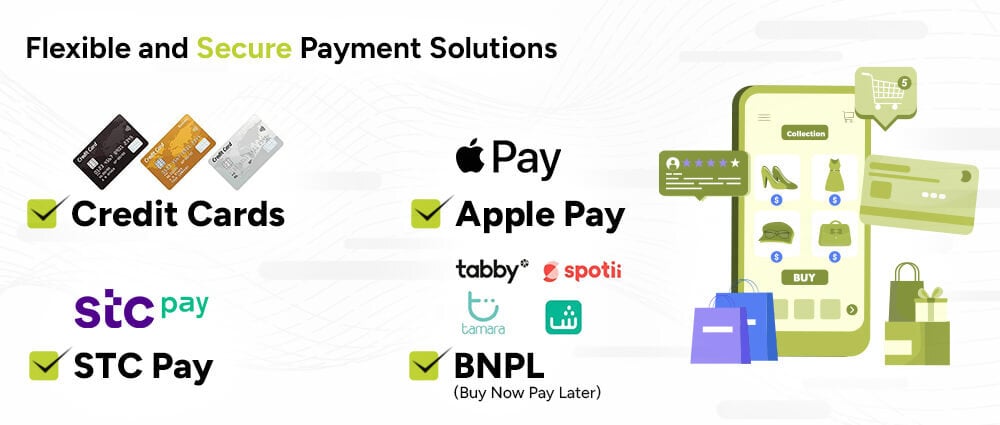If you’ve been watching the digital space in the Middle East, you’ve probably noticed something huge: the e-commerce industry is at an all-time high. From local startups to big international players entering the market, online shopping is no longer a side hustle. It’s front and center. But what’s really driving this growth? The software behind these online stores.
Let’s take a friendly dive into the e-commerce trends in the software industry and see how things are shaping up across the region.
People in the Middle East are spending more time on their phones than ever before and they’re using them to shop. Mobile-first e-commerce platforms are becoming the norm.
Software developers are focusing on building responsive, fast, and seamless mobile shopping experiences, from personalized product feeds, and e-commerce site with amazing navigation to one-click checkouts. If your e-commerce platform doesn’t work smoothly on mobile, you’re probably missing out on a huge chunk of customers.
One major thing setting the Middle East apart in terms of e-commerce software trends is the need for strong localization. Platforms that support Arabic language, RTL layouts, and local payment gateways (like Mada in Saudi Arabia or Fawry in Egypt) are winning hearts and sales.
Today’s e-commerce software isn’t just about selling; it’s about connecting. And to connect, you need to speak your customer’s language, literally.
Artificial Intelligence (AI) is popping up everywhere in e-commerce, especially in recommendation engines and chatbots. Want to offer a product suggestion that feels like it was handpicked? AI is how you get it.
Retailers in the Middle East are adopting smart algorithms that can track user behavior, shopping history, and even regional trends to deliver a hyper-personalized shopping experience. They also realize the role of voice search assistant in ecommerce to promote accessibility and diversity for their customers.
This is one of the current trends in e-commerce that’s growing fast. People are buying directly from Instagram, TikTok, and Snapchat.
E-commerce platforms in the Middle East are now integrating with social media more deeply, offering “Shop Now” buttons, influencer store links, and even live shopping features. Software that combines e-commerce and social seamlessly? That’s the future. This also enables you to gather social proof for e-commerce sales.

Cash on delivery used to be king, but not anymore. Customers now expect options—credit cards, Apple Pay, STC Pay, BNPL (Buy Now Pay Later), you name it.
E-commerce software must integrate with a variety of payment gateways, and more importantly, keep things secure. With the rise of digital payments comes the need for robust cybersecurity measures, something developers are actively working on in 2025.
Gone are the days of clunky self-hosted stores. Now make way for more businesses preferring to move to flexible, scalable, cloud-based e-commerce solutions that are easier to manage.
Most particularly for small and medium enterprises in the Middle East that want the best enterprise-level applications minus the biting costs or heavy infrastructure.
Online store? Check. Instagram shop? Check. WhatsApp orders? Check.
Modern e-commerce isn’t about having a store, it’s about being everywhere. Software is evolving to help businesses manage inventory, customer service, and marketing across multiple channels without missing a beat.
Yes, even in software! Consumers, especially younger ones, are more conscious about where and how they shop.
Brands are now using e-commerce platforms that highlight sustainability features, from eco-friendly packaging tracking to carbon footprint estimators. Expect more software tools in 2025 that make it easy to sell ethically.

Some key benefits of following the latest trends in the e-commerce software industry, especially for businesses in the Middle East:
Personalized recommendations, faster mobile apps, and localized interfaces (like Arabic support) make shopping more enjoyable.
Happy customers = repeat customers.
AI, smart payment gateways, and one-click checkouts reduce friction in the buying process.
Trends like Buy Now, Pay Later (BNPL) make it easier for customers to say yes.
Following localization trends helps you better connect with Middle Eastern audiences, culturally and linguistically.
You gain trust by offering familiar experiences, like local currencies and payment methods.
By using social commerce tools, you meet your audience where they spend the most time—on Instagram, TikTok, and Snapchat.
This leads to more organic sales and brand visibility.
Cloud-based and omnichannel software solutions help you manage everything from inventory, to orders, and marketing, all in one place.
Saves time, reduces errors, and improves scalability.
Staying updated with the e-commerce trends 2025 puts you ahead of slower-moving competitors.
You appear more innovative and modern to customers.
Adopting the latest cybersecurity measures in e-commerce software protects customer data and your brand’s reputation.
Builds confidence in online transactions.
Leveraging green e-commerce software tools not only helps the planet, it also resonates with eco-conscious consumers.
Adds a unique value proposition to your brand.
Whether you’re a developer, a business owner, or just someone interested in the industry, the trends in the e-commerce software industry in the Middle East are clear: Faster, smarter, more connected, and culturally in-tune.
If you’re planning to start or grow your online store, now’s a great time to explore what the latest e-commerce trends in software industry can do. Contact Arpatech today and work with the best e-commerce software development experts for your business.
The major trends include mobile-first shopping, AI personalization, social commerce, omnichannel experiences, and flexible payments.
Some of the latest trends include:
There are several, including:
The future is all about personalization, automation, and multi-channel presence. AI, AR, and VR are also expected to play a bigger role, along with an increased focus on sustainability and data security.